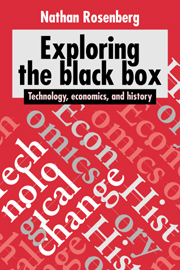Introduction
Published online by Cambridge University Press: 12 November 2009
Summary
The principal focus of this book is the process by which information – new information as well as old – comes to be embedded in new technologies. The process is not a straightforward matter. Indeed, if it were, most of the chapters of this book would be superfluous. In fact, the main purpose of the book is to provide a better understanding of the diversity of that process, as well as some of the implications of that diversity. Technological change is an extraordinarily complex subject that takes a multiplicity of forms and directions, often requiring different angles of vision for different industries as well as for different periods of history.
Consequently, one recurring focus of interest here is the way in which, and the extent to which, the information necessary for technological improvement can be deduced from existing bodies of theoretical knowledge. Much of the discussion in the following pages differs from other approaches to the economics of technological change by paying explicit attention to the qualitative features of information acquisition. This involves distinguishing between the emergence of theories and concepts, on the one hand, and the often costly empirical experimentation associated with product design in the context of firms pursuing profits in the market place, on the other. While product design and market viability are often informed by theory – for example, a background in chemistry is distinctly helpful in the synthesis of a new molecule – most of the important details need not be a consequence of scientific theory of any sort.
- Type
- Chapter
- Information
- Exploring the Black BoxTechnology, Economics, and History, pp. 1 - 6Publisher: Cambridge University PressPrint publication year: 1994



